| Supported Target Version |
|---|
| Qumulo Core 5.3.1 |
Application Version and Upgrade Details
| Application Version | Bug fixes / Enhancements |
|---|---|
| 1.1.0 | Changed the Resource Type from Other to File System for the nativeTypes Qumulo NFS Export and Qumulo SMB Share. |
| 1.0.0 | Initial resource discovery and monitoring implementations. |
Introduction
Qumulo Core is a high-performance file data platform designed to store, manage and create workflows and applications with data in its native file form at a massive scale across hybrid cloud environments. With Qumulo you can easily manage the full data lifecycle from ingestion, transformation, publishing and archiving with cost-effective capacity, dynamic scalability, automatic encryption, real-time analytics and an advanced API that enables customers to easily integrate Qumulo into their technology ecosystem and workflows.
Key Use cases
Discovery Use cases
- It discovers the Qumulo components.
- Publishes relationships between resources to have a topological view and ease of maintenance.
Monitoring Use cases
- Provides metrics related to job scheduling time and status etc..
- Concern alerts will be generated for each metric to notify the administrator regarding the issue with the resource
Prerequisites
- Classic gateway version should be 14.0.0 and above.
- Nextgen gateway version should be 14.0.0 and above.
Note: OpsRamp recommends using the latest Gateway version for full coverage of recent bug fixes, enhancements, etc.
Hierarchy of Qumulo
· Qumulo Cluster
· Qumulo Node
· Qumulo Cluster Disk
· Qumulo Quota
· Qumulo SMB Share
· Qumulo NFS Export
Supported Metrics
Click here to view the supported metrics
| Native Type | Metric Name | Display Name | Units | Application Version | Description |
|---|---|---|---|---|---|
| Qumulo Cluster | qumulo_cluster_fs_capacity_bytes | Qumulo Cluster Filesystem Capacity Bytes | Bytes | 1.0.0 | Qumulo cluster filesystem capacity in bytes |
| qumulo_cluster_fs_directory_tree_entries | Qumulo Cluster Filesystem Directory Tree Entries | count | 1.0.0 | Qumulo cluster filesystem directory tree entries | |
| qumulo_cluster_fs_directory_used_bytes | Qumulo Cluster Filesystem Directory Used Bytes | Bytes | 1.0.0 | Qumulo cluster filesystem directory used bytes | |
| qumulo_cluster_fs_free_bytes | Qumulo Cluster Filesystem Free Bytes | Bytes | 1.0.0 | Qumulo cluster filesystem free bytes | |
| qumulo_cluster_fs_snapshots | Qumulo Cluster Filesystem Snapshots | count | 1.0.0 | Qumulo cluster filesystem snapshots | |
| qumulo_cluster_ldap_operation_errors_Total | Qumulo Cluster Ldap Operation Errors Total | count | 1.0.0 | Qumulo cluster Ldap operation total errors | |
| qumulo_cluster_ldap_operation_latency_count | Qumulo Cluster Ldap Operation Latency Count | s | 1.0.0 | Qumulo cluster Ldap operation latency count | |
| qumulo_cluster_ldap_operation_latency_Sum | Qumulo Cluster Ldap Operation Latency Sum | s | 1.0.0 | Qumulo cluster Ldap operation latency sum | |
| qumulo_cluster_ldap_operation_latency_Bucket | Qumulo Cluster Ldap Operation Latency Bucket | s | 1.0.0 | Qumulo cluster Ldap operation latency bucket | |
| qumulo_cluster_ldap_operation_referrals_Total | Qumulo Cluster Ldap Operation Referrals Total | count | 1.0.0 | Qumulo cluster Ldap operation referrals total | |
| qumulo_cluster_ldap_operations_Total | Qumulo Cluster Ldap Operations Total | count | 1.0.0 | Qumulo cluster Ldap total operations | |
| qumulo_cluster_protocol_clientconnectionsTotal | Qumulo Cluster Protocol Client Connections Total | count | 1.0.0 | Qumulo cluster protocol client connections total | |
| qumulo_cluster_protocol_clientDisconnectionsTotal | Qumulo Cluster Protocol Client Disconnections Total | count | 1.0.0 | Qumulo cluster protocol client disconnections | |
| qumulo_cluster_protocol_operationbytesTotal | Qumulo Cluster Protocol Operation Bytes Total | Bytes | 1.0.0 | Qumulo cluster protocol operation total bytes | |
| qumulo_cluster_protocol_operationlatency_Count | Qumulo Cluster Protocol Operation Latency Count | s | 1.0.0 | Qumulo cluster protocol operation latency count | |
| qumulo_cluster_protocol_operationlatency_Sum | Qumulo Cluster Protocol Operation Latency Sum | s | 1.0.0 | Qumulo cluster protocol operation latency sum | |
| qumulo_cluster_protocol_operationlatency_Bucket | Qumulo Cluster Protocol Operation Latency Bucket | s | 1.0.0 | Qumulo cluster protocol operation latency bucket | |
| qumulo_cluster_protocol_operations_readTotal | Qumulo Cluster Protocol Operations Read Total | count | 1.0.0 | Qumulo cluster protocol operations read total | |
| qumulo_cluster_protocol_operations_writeTotal | Qumulo Cluster Protocol Operations Write Total | count | 1.0.0 | Qumulo cluster protocol operations write total | |
| Qumulo Node | qumulo_node_Status | Qumulo Node Status | 1.0.0 | Qumulo node status. Possible values are - online :0 , other :1 | |
| qumulo_node_psuStatus | Qumulo Node PSU Status | 1.0.0 | Qumulo node power supply unit status. Possible values are - GOOD :0 , MISSING :1, NO AC :2, UNKNOWN : 3 | ||
| qumulo_node_cpu_temperature | Qumulo Node CPU Temperature | C | 1.0.0 | Qumulo node cpu temperature | |
| qumulo_node_memory_correctable_ecc_errors_total | Qumulo Node Memory Correctable Ecc Errors Total | count | 1.0.0 | Qumulo node memory correctable Ecc errors | |
| qumulo_node_networkinterface_isDown | Qumulo Node Network Interface IsDown | 1.0.0 | Qumulo node network interface status. Possible values are - 0 : false, 1 : true | ||
| qumulo_node_networkinterface_linkSpeed | Qumulo Node NetworkInterface LinkSpeed | bps | 1.0.0 | Qumulo node network interface link speed | |
| qumulo_node_networkinterface_receiveerrorsTotal | Qumulo Node NetworkInterface ReceiveErrors Total | count | 1.0.0 | Qumulo node network interface total receive errors. | |
| qumulo_node_networkinterface_receivedbytesTotal | Qumulo Node NetworkInterface ReceivedBytes Total | Bytes | 1.0.0 | Qumulo node network interface total received bytes | |
| qumulo_node_networkinterface_receivedpacketsTotal | Qumulo Node NetworkInterface ReceivedPackets Total | count | 1.0.0 | Qumulo node network interface total received packets. | |
| qumulo_node_networkinterface_transmiterrorsTotal | Qumulo Node NetworkInterface TransmitErrors Total | count | 1.0.0 | Qumulo node network interface total transmit errors. | |
| qumulo_node_networkinterface_transmittedbytesTotal | Qumulo Node NetworkInterface TransmittedBytes Total | Bytes | 1.0.0 | Qumulo node network interface total transmitted bytes | |
| qumulo_node_networkinterface_transmittedpacketsTotal | Qumulo Node NetworkInterface TransmittedPackets Total | count | 1.0.0 | Qumulo node network interface total transmitted packets. | |
| Qumulo Cluster Disk | qumulo_cluster_disk_State | Qumulo Cluster Disk State | 1.0.0 | Qumulo cluster disk state. Possible values are - dead : 0, empty :1 , missing : 2, wrong_cluster :3, wrong_node :4, wrong_version : 5, healthy : 6 | |
| qumulo_cluster_disk_endurance | Qumulo Cluster Disk Endurance | 1.0.0 | Qumulo cluster disk endurance. | ||
| qumulo_cluster_disk_isUnhealthy | Qumulo Cluster Disk isUnhealthy | 1.0.0 | Qumulo cluster disk health status. Possible values are - 0 : false, 1:true | ||
| qumulo_cluster_disk_operationLatencyCount | Qumulo Cluster Disk Operation Latency Count | s | 1.0.0 | Qumulo cluster disk operation latency count | |
| qumulo_cluster_disk_operationLatencySum | Qumulo Cluster Disk Operation Latency Sum | s | 1.0.0 | Qumulo cluster disk operation latency sum | |
| qumulo_cluster_disk_operationLatencyBucket | Qumulo Cluster Disk Operation Latency Bucket | s | 1.0.0 | Qumulo cluster disk operation latency bucket. | |
| Qumulo Quota | qumulo_quota_capcityUsage | Qumulo Quota Capacity Usage | Bytes | 1.0.0 | Qumulo quota capacity usage. |
Default Monitoring Configurations
Qumulo has default Global Device Management Policies, Global Templates, Global Monitors and Global metrics in OpsRamp. Users can customize these default monitoring configurations as per their business use cases by cloning respective global templates and global Device Management Policies. OpsRamp recommends doing this activity before installing the app to avoid noise alerts and data.
Default Global Device Management Policies
OpsRamp has a Global Device Management Policy for each Native Type of Qumulo. You can find those Device Management Policies at Setup > Resources > Device Management Policies, search with suggested names in global scope. Each Device Management Policy follows below naming convention:
{appName nativeType - version}Ex: qumulo Qumulo Cluster - 1 (i.e, appName = qumulo , nativeType = Qumulo Cluster , version = 1)
Default Global Templates
OpsRamp has a Global template for each Native Type of Qumulo. You can find those templates at Setup > Monitoring > Templates, search with suggested names in global scope. Each template follows below naming convention:
{appName nativeType 'Template' - version}Ex: qumulo Qumulo Cluster Template - 1 (i.e, appName = qumulo , nativeType = Qumulo Cluster, version = 1)
Default Global Monitors
OpsRamp has a Global Monitors for each Native Type which has monitoring support. You can find those monitors at Setup > Monitoring > Monitors, search with suggested names in global scope. Each Monitors follows below naming convention:
{monitorKey appName nativeType - version}Ex: Qumulo Cluster Monitor qumulo Qumulo Cluster 1(i.e, monitorKey = Qumulo Cluster Monitor , appName = qumulo, nativeType = Qumulo Cluster , version = 1)
Configure and Install the Qumulo Integration
- From All Clients, select a client.
- Go to Setup > Account.
- Select the Integrations and Apps tab.
- The Installed Integrations page, where all the installed applications are displayed. Note: If there are no installed applications, it will navigate to the ADD APP page.
- Click + ADD on the Installed Integrations page. The Available Integrations and Apps page displays all the available applications along with the newly created application with the version.
Note: You can even search for the application using the search option available. Also you can use the All Categories option to search.

- Click ADD in the Qumulo application.
Note: Select the version from the drop down menu. - In the Configurations page, click + ADD. The Add Configuration page appears.
- Enter the below mentioned Basic Information:
| Functionality | Description |
|---|---|
| Name | Enter the name for the configuration. |
| IP Address/Host Name of Qumulo Resource | IP address/host name of the target. |
| API Port | API Port details Note: By default 443 is displayed. |
| Qumulo Credential | Select the Credential from the drop-down list. (Optional): Click + Add to create a credential. The ADD CREDENTIAL window is displayed. Enter the following information.
|
Notes
- By default the Is Secure checkbox is selected.
- Host Name/IP Address and Port should be accessible from Gateway.
- Select the following:
- App Failure Notifications: if turned on, you will be notified in case of an application failure that is, Connectivity Exception, Authentication Exception.
- Select the below mentioned Custom Attribute:
| Functionality | Description |
|---|---|
| Custom Attribute | Select the custom attribute from the drop down list box. |
| Value | Select the value from the drop down list box. |
Note: The custom attribute that you add here will be assigned to all the resources that are created by the integration. You can add a maximum of five custom attributes (key and value pair).
In the RESOURCE TYPE section, select:
- ALL: All the existing and future resources will be discovered.
- SELECT: You can select one or multiple resources to be discovered.
In the DISCOVERY SCHEDULE section, select Recurrence Pattern to add one of the following patterns:
- Minutes
- Hourly
- Daily
- Weekly
- Monthly
Click ADD.
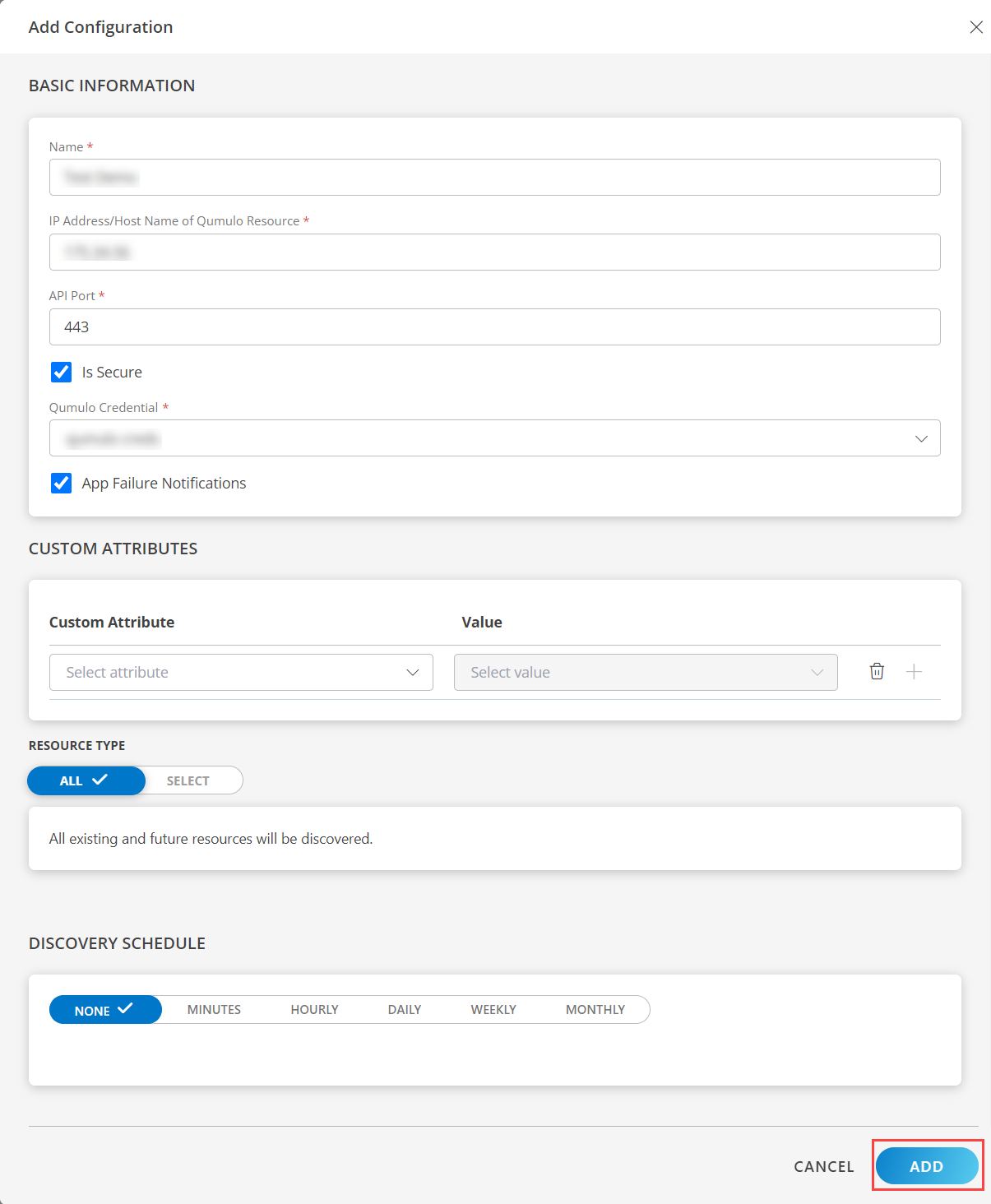
Now the configuration is saved and displayed on the configurations page after you save it.
Note: From the same page, you may Edit and Remove the created configuration.
Under the ADVANCED SETTINGS, Select the Bypass Resource Reconciliation option, if you wish to bypass resource reconciliation when encountering the same resources discovered by multiple applications.
Note: If two different applications provide identical discovery attributes, two separate resources will be generated with those respective attributes from the individual discoveries.
Click NEXT.
(Optional) Click +ADD to create a new collector by providing a name or use the pre-populated name.
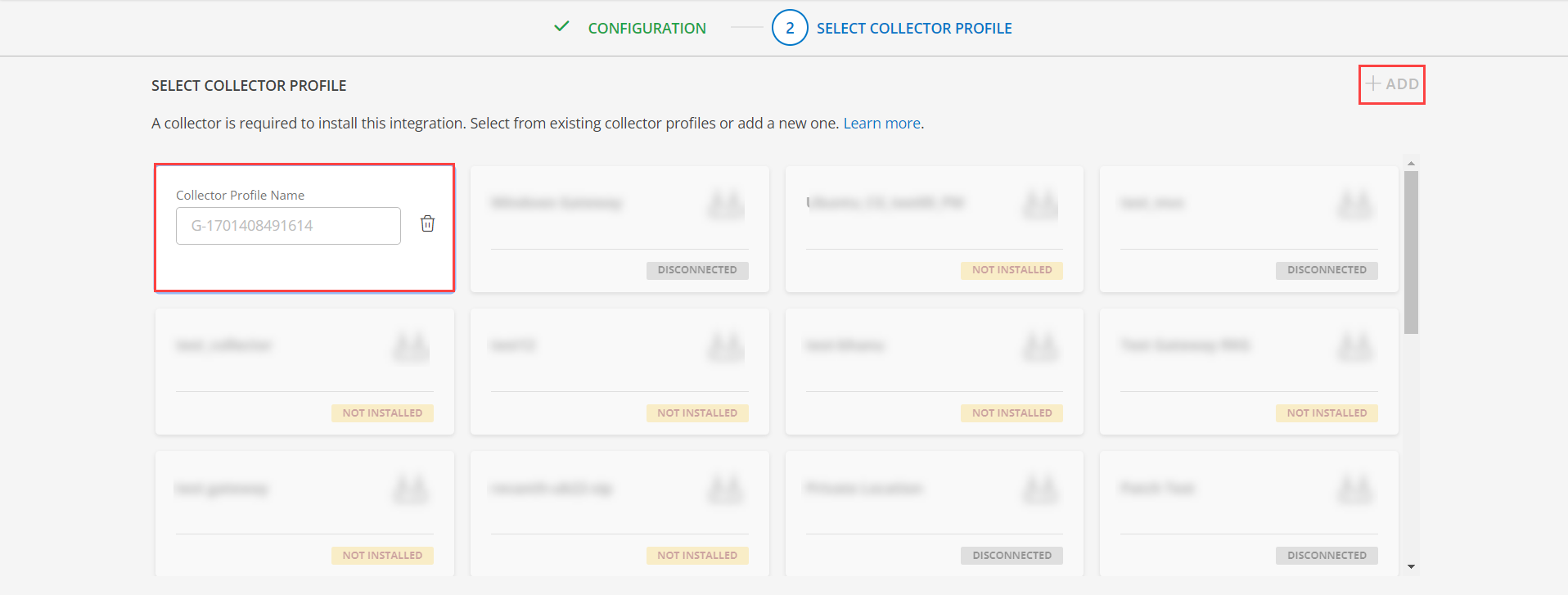
- Select an existing registered profile.
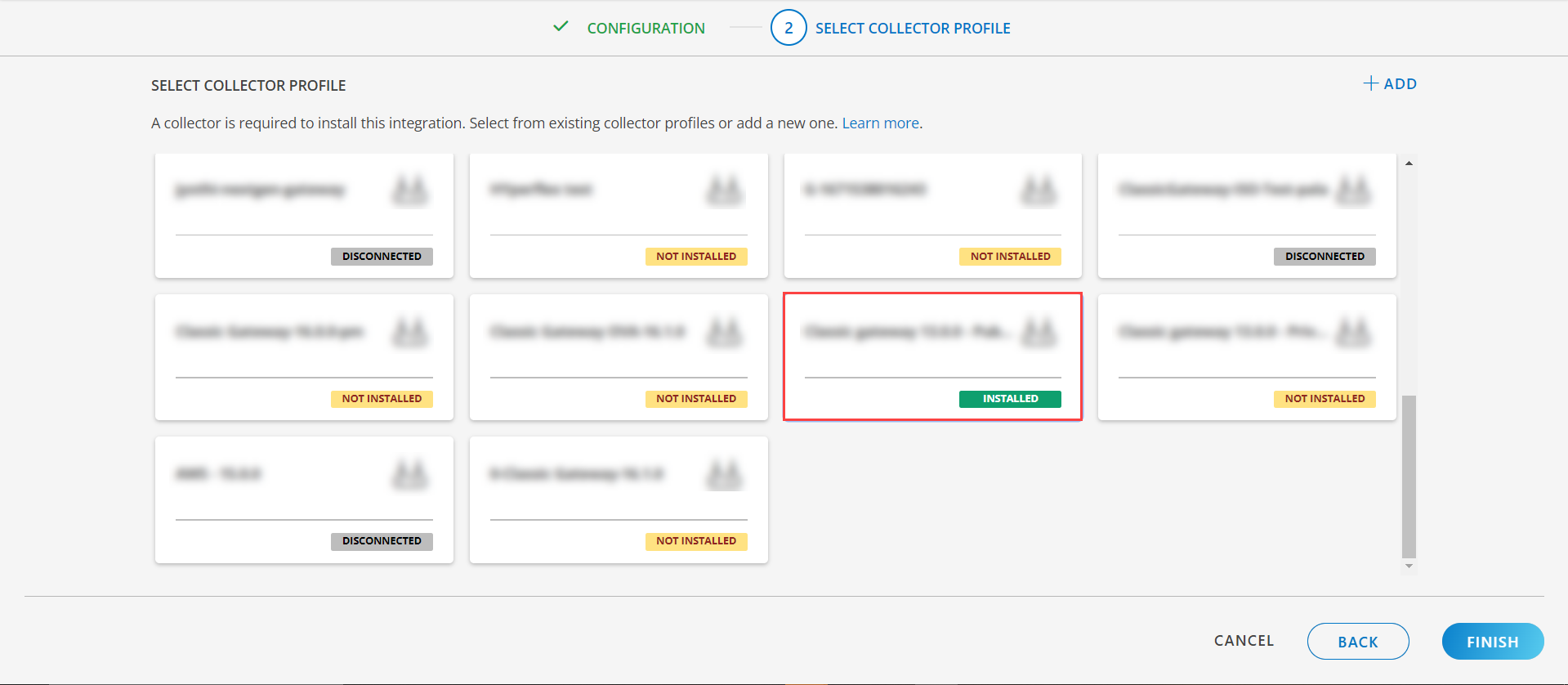
- Click FINISH.
The application is installed and displayed on the INSTALLED INTEGRATION page. Use the search field to find the installed integration.
Modify the Configuration
See Modify an Installed Integration or Application article.
Note: Select the Qumulo application.
View the Qumulo Details
To discover resources for Qumulo.
- Navigate to Infrastructure > Search > Servers and VMs > Qumulo.
- The Qumulo page is displayed, select the application name.
- The RESOURCE page appears from the right.
- Click the ellipsis (…) on the top right and select View details.
- Navigate to the Attributes tab to view the discovery details.
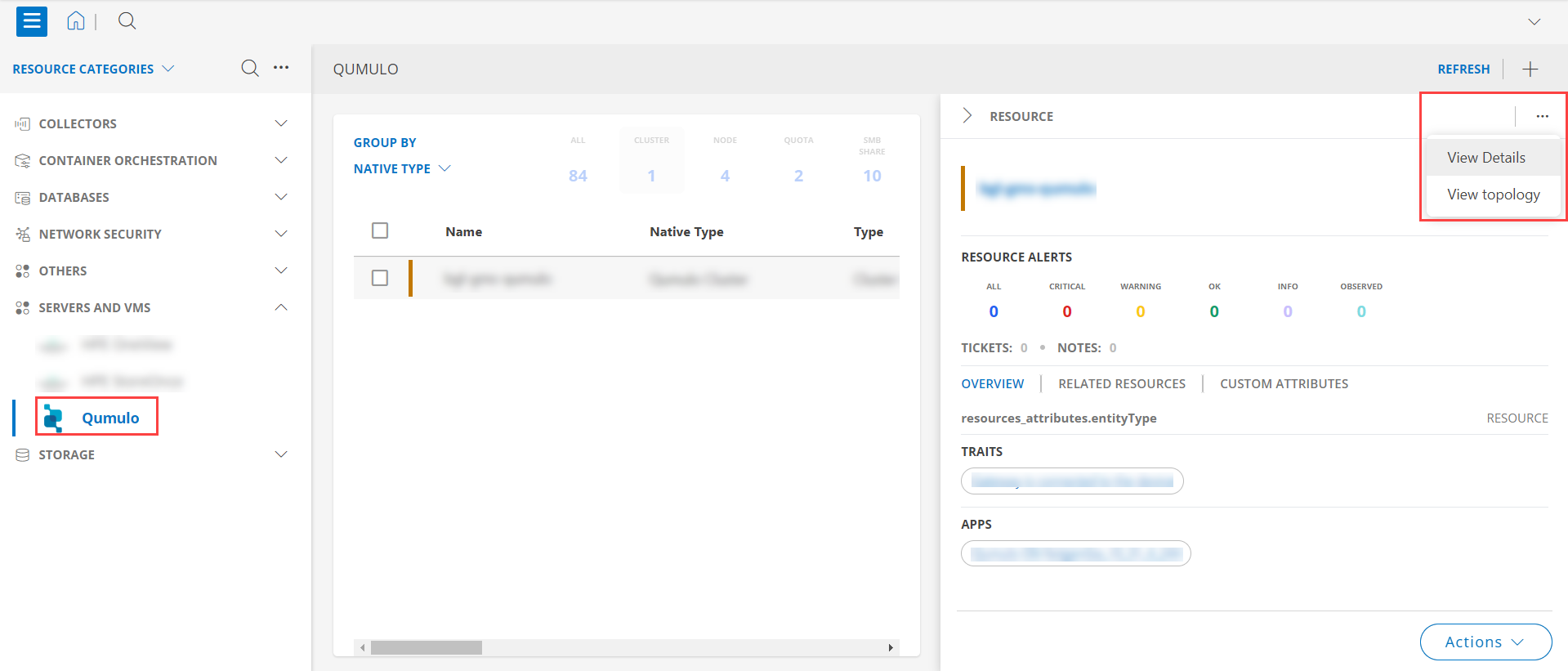
- Click the Metrics 2.0 tab to view the metric details for Qumulo.
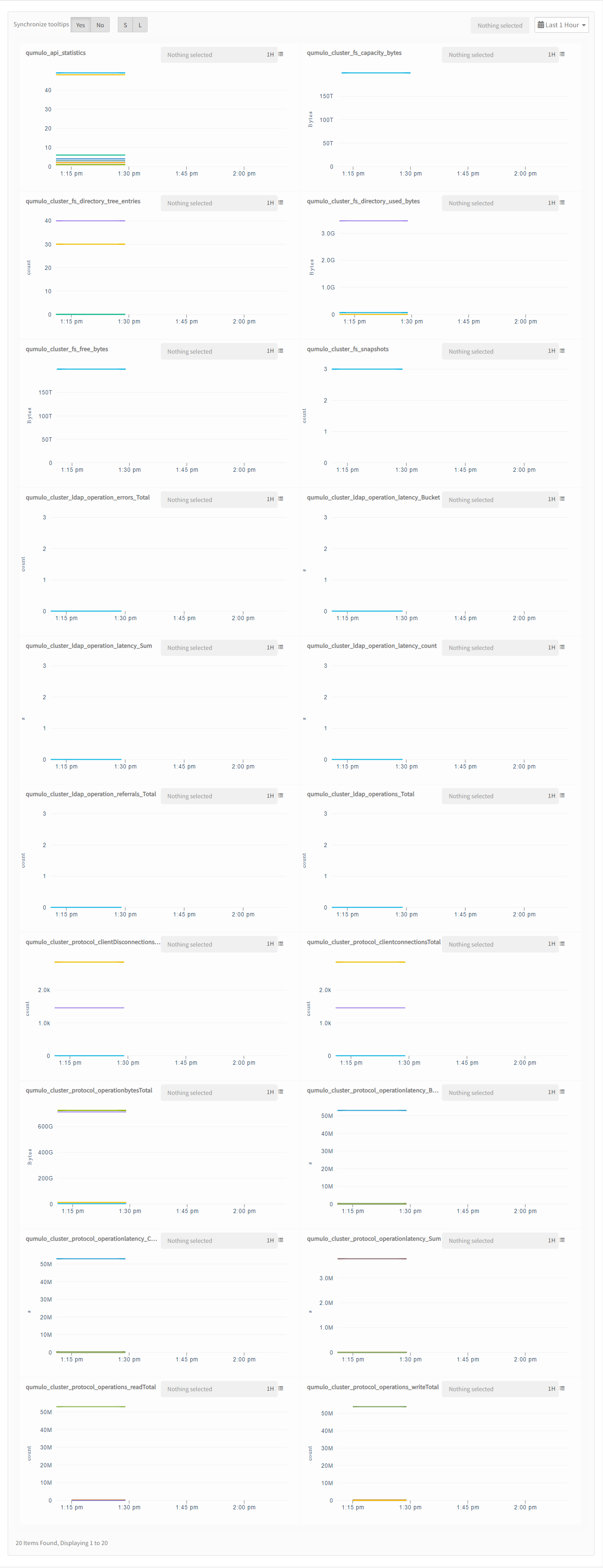
Resource Filter Input keys
Qumulo Resources are filtered and discovered based on below keys:
Click here to view the Supported Input Keys
| Resource Type | Supported Input Keys |
|---|---|
| All Types | resourceName |
| hostName | |
| aliasName | |
| dnsName | |
| ipAddress | |
| macAddress | |
| os | |
| make | |
| model | |
| serialNumber | |
| Qumulo Cluster | Build Date |
| Build ID | |
| Version | |
| Qumulo Server | Node ID |
| Qumulo Quota | Limit |
| Qumulo SMB Share | Default Directory Create Mode |
| Default File Create Mode | |
| Qumulo NFS Export | FileSystem Path |
| Read Only | |
| Require Privileged Port | |
| User Mapping | |
| Qumulo Cluster Disk | Disk Type |
| Drive Bay | |
| Node ID | |
| Slot | |
| Slot Type |
Supported Alert Custom Macros
Customize the alert subject and description with below macros then it will generate alerts based on customisation.
Supported macros keys:
Click here to view the alert subject and description with macros
${resource.name}
${resource.ip}
${resource.mac}
${resource.aliasname}
${resource.os}
${resource.type}
${resource.dnsname}
${resource.alternateip}
${resource.make}
${resource.model}
${resource.serialnumber}
${resource.systemId}
${parent.resource.name}
${Custom attributes on the resource}
Risks, Limitations & Assumptions
- Application can handle Critical/Recovery failure notifications for below two cases when user enables “App Failure Notifications” in configuration.
- Connectivity Exception
- Authentication Exception
- Application will send any duplicate/repeat failure alert notification for every 6 hours.
- Using metrics for monitoring the resources and generating alerts when the threshold values are breached.
- Application cannot control monitoring pause/resume actions based on above alerts.
- This application supports only Classic Gateway and NextGen Gateway. Not supported with Cluster Gateway.
- Component level thresholds can be configured on each resource level.
- No support of showing activity log and applied time.
- Latest snapshot metric support from Gateway 14.0.0.